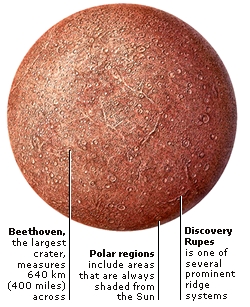DK Science: Mercury
Mercury is the planet closest to the Sun, and experiences scorching temperatures by day. But it has virtually no atmosphere to trap the heat, so is freezing at night. It is a rocky planet, just over a third the diameter of Earth. Its surface is covered with craters, which make it look similar to parts of the Moon. These craters were formed when the planet was bombarded with meteorites long ago.
Table 9. ESSENTIAL DATA
| Diameter at equator | 4,880 km (3,032 miles) |
| Average distance from Sun | 57.9 million km (36 million miles) |
| Orbital period | 88 days |
| Rotation period | 58.7 days |
| Mass (Earth=1) | 0.06 |
| Gravity (Earth=1) | 0.38 |
| Average surface temperature | 167°C (332°F) |
| Number of moons | 0 |

